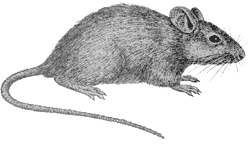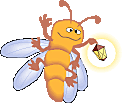Spring, 1999
© Moore Consulting, 1999.
All Rights Reserved
Wise
Perimeter Protection
Are
Pests Increasing?
Pest Prevention
Tip of the Month
"Hot
Bugs"
Designing
Spiders
Your
Questions Answered
Insects
in Your Food
Trivia
 Anyone
who has studied insects outdoors is surprised at the number and
diversity of insects. To this day we don't know how many kinds
there are--thousands of new species are discovered every year
right here in the United States. Over a million species of insects
have already been named, and worldwide some scientists estimate
that there are 10 million more insect species waiting to be discovered
and named.
Anyone
who has studied insects outdoors is surprised at the number and
diversity of insects. To this day we don't know how many kinds
there are--thousands of new species are discovered every year
right here in the United States. Over a million species of insects
have already been named, and worldwide some scientists estimate
that there are 10 million more insect species waiting to be discovered
and named.
So it should come as no surprise that a typical backyard is a breeding and dwelling place for several thousand different kinds of bugs. With so many living in a yard, it's also no wonder that some of these will wander indoors through the small cracks and other openings on the exterior of your home, through windows and doors, etc.
In fact, many serious indoor pest problems begin when pests invade from outdoors. Think of ants, flies, crickets, earwigs, millipedes, spiders, etc. Usually these pests invade your home from your own yard, although they can originate from other sources. Pests often slip in just a few at a time, but sometimes huge numbers of them migrate indoors from nearby gathering areas.
That's why our perimeter treatments are so important. By professionally treating around the outside of your foundation, Stanley Pest Control can stop many bugs before they ever enter your home.
Perimeter treatments are just one of the important tools we use to enable you to enjoy the benefits of a pest-free life!
Back to top
Are
Pests Increasing?
It seems like the
never-ending battle against pests becomes more fierce every year.
We increasingly hear about pests on the news and from friends,
and they are constantly invading our homes and businesses. What
is happening?
For one thing, we are battling a far greater variety of pests today than ever before. In fact, most of our worst pest species did not come from this country. Pests like the common house fly, house mouse, roof and Norway rats, and the American, German, and Oriental cockroaches, to name a few, all came from other countries. There are now well over 1,700 species of foreign pests thriving in this country, mainly due to the constant movement of people and goods between countries and continents.
As if that weren't bad enough, we often inadvertently promote pest problems. For instance, sanitation measures have generally improved, thus reducing pest numbers, but recycling has created entirely new problems by providing pests with enticing nutritious liquids left in bottles and cans. Central heating keeps us warm during the winter, but it has also allowed termites to thrive in areas where they weren't previously a problem. Pests will take advantage of any food, water or suitable shelter we provide them.
And what about the potential for global warming we hear about in the news? Just a couple of degrees increase in temperature would mean longer pest seasons, increased winter survival of pests, and a whole new group of pests. Let's hope that doesn't happen, but as always, Stanley will be ready for them if it does!
Back to top
Pest Prevention Tip of the Month
 The
number of night-flying insects will increase in the months ahead.
If you have a bright light outside next to a door, pests will
fly in when you open the door at night. Either replace the white
blub with a yellow one, or move the fixture away from all doors
and windows.
The
number of night-flying insects will increase in the months ahead.
If you have a bright light outside next to a door, pests will
fly in when you open the door at night. Either replace the white
blub with a yellow one, or move the fixture away from all doors
and windows.
The Hanford nuclear complex in Washington, the site that produced plutonium for nuclear weapons until the 1980's, still has some highly radioactive areas. While no giant radioactive mutant insects (like the famous 1954 movie, "Them!") have been seen on the site, radioactive insects have recently been found there.
First it was red harvester ants that were discovered in the complex near old waste pipes. Then more recently, radioactive flying insects were found around garbage cans at the site, where no radioactive garbage is disposed of.
That prompted the officials to check the town dump, where they found trash that had become radioactive apparently by contact with insects. Workers sent 210 tons of the garbage back to Hanford for burial. Fortunately the contamination was only slight--a person would have had to stand next to a spot contaminated by radioactive bugs for an hour to get a level of exposure equal to a dental x-ray.
While the chances of radioactive insects leaving the 560 square-mile complex are very remote, still, Hollywood should be able to make a good science fiction movie out of this. Seen any mutant bugs lately?
Meanwhile, Hanford is working to eradicate its "hot" insects.
Spiders know what they are doing when it comes to building webs.
If a web directly
faces a strong wind, the web will billow out and break. So spiders
naturally build their webs at an angle to the prevailing breeze,
enabling them to withstand a much stronger wind.
Q. How effective are lice shampoos at controlling head lice?
A. Probably because head lice are so common (10 million Americans, mostly grade school children, are infested with head lice every year), they are showing some apparent resistance to the shampoos used to control them. In fact, the Federal Trade Commission recently charged three companies that sell lice shampoos with making "false and unsubstantiated claims." All three companies claimed their products were 100% effective, and two companies claimed only one treatment was needed.
In fact, it now typically takes at least two shampoos to kill the lice. The shampoos do a poor job of killing the eggs (nits), so a second shampooing 7 to 10 days after the first one is needed to kill the lice that hatched since the first shampooing. Plus, it is recommended that combing and hand removal of the nits from the hair be done after the first shampooing.
The new labels are required to state "reapplication and egg removal are required to ensure complete effectiveness."
Head lice shampoos are still an essential part of lice control, along with cleaning combs, and teaching your children not to borrow combs, hats, etc., from classmates.
Back to top
Insects in Your Food
New statistics show that every American unknowingly eats about 1 1/2 pounds of insects a year. That's when you count up all the insects like aphids and caterpillars hidden in broccoli, lettuce, and other fresh foods, plus the bugs ground up in processed foods in everything from cornflakes to strawberry jam to spaghetti sauce.
Actually, we're none the worse for eating these insects. As long as the insects are clean and cooked, they don't harm us.
As some people like to point out, insects are extremely high in protein (dried grasshoppers are up to 60% protein), so some in our food actually makes it more nutritious.
People who knowingly eat insects have different descriptions of how they taste. Many insects, once cooked, taste vaguely of chicken, or even their distant relatives, shrimp and lobster. They may have a nutty or crispy texture. Cooked tarantulas have been described as "greasy, but good."
1. How much damage is done to property in the U.S. by rats and mice in one day?
2. What insect will soon have a new museum devoted entirely to it?
3. What is the world's population of ants?
4. How do an insect's tiny wings enable it to fly?
ANSWERS TO PEST TRIVIA!
1. About $2,500,000 or nearly one billion dollars a year in the U.S.
2. Mosquitoes, opening in Sweden this summer.
3. At any given moment, there are 10 million billion ants. They weigh over 2 billion pounds and constitute 10% of the entire animal biomass on dry land.
4. An airplane and an insect use vastly different strategies to lift their bodies into the air. An insect's wings, as reported in a recent issue of the journal, "Nature," create their lift by producing a whirling cylinder of air above the insect, lifting their body into the air like a miniature tornado. An airplane's wings lift the plane due to the flow of air over the wing. This creates lower air pressure above the wings which lifts the plane.